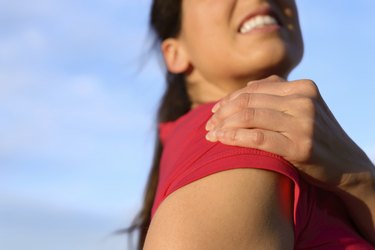
Suffering from pain in your shoulders or upper back during exercise isn't normal and may be cause for concern, especially if it makes working out difficult. These aches can have several different causes, and figuring out the cause of your pain is the key to eliminating it and getting back to your workout routine.
Posture Problems
Video of the Day
For many, upper back ache and shoulder pain during or after exercise is caused by posture problems. Slumping over and rounding your shoulders forward could put stress on your neck and shoulders and lead to aches and pains. Before doing any exercises, make a conscious effort to roll your shoulders back, tuck in your chin and tighten your abdominals. This will keep your posture straight and prevent throwing an extra load on your upper back.
Video of the Day
Pulled Muscle
In some cases, a pulled or strained muscle could be to blame for your upper back or shoulder aches. This sort of injury tends to occur with repetitive movements as with playing tennis or lifting weights. Improper lifting technique could also strain the ligaments and muscles around your joints, leading to pulls, strains and even tears. Make sure every movement you make is controlled to prevent injuring yourself in this manner.
Tendonitis
Tendonitis is another possible reason for your shoulder and upper back ache during exercise. This can occur when you overuse a joint. Most common in activities that require repetitive movements, tendonitis of the shoulder often affects the rotator cuff. Once the tendon is inflamed, it will continue to hurt until you rest it and it's allowed to heal. If you suspect tendonitis, abstain from exercise and ice the area often.
Prevention
The best way to treat shoulder and upper back ache from exercise is to prevent it altogether. Practicing proper posture, using proper form when you lift weights or perform exercises and remembering to warm up and cool down can prevent most injuries and leave you pain free. Over-the-counter pain relievers may also be used to reduce inflammation and swelling.